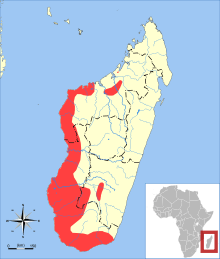Bastard big-footed mouse
The bastard big-footed mouse (Macrotarsomys bastardi) is a species of rodent in the family Nesomyidae. It is found only in Madagascar. Macrotarsomys bastardi is the smallest-bodied of the three species recognized within the genus Macrotarsomys.[2] Two subspecies have been recognized (M. b. occidentalis and M. b. bastardi) however 2004 studies did not find consistent differences between the subspecies and recommended "subspecific epithets be abandoned for this species".[2]
| Bastard big-footed mouse | |
|---|---|
| Scientific classification | |
| Kingdom: | Animalia |
| Phylum: | Chordata |
| Class: | Mammalia |
| Order: | Rodentia |
| Family: | Nesomyidae |
| Genus: | Macrotarsomys |
| Species: | M. bastardi |
| Binomial name | |
| Macrotarsomys bastardi Milne-Edwards & G. Grandidier, 1898 | |
 | |
| Bastard big-footed mouse range | |
Habitat
This is a terrestrial species, found primarily in xeric habitats such as dry deciduous forests in the northwest and spiny forests in the south.[2]
gollark: Fun fact: the word "based" has been used 3897 times here.
gollark: I like squares more than circles.
gollark: AutoBotRobot idea: haiku detector.
gollark: ++remind 1w <@156021301654454272> esobot?
gollark: OCaml seemingly good.
References
- Kennerley, R. (2016). "Macrotarsomys bastardi". IUCN Red List of Threatened Species. 2016: e.T12647A22236959. doi:10.2305/IUCN.UK.2016-2.RLTS.T12647A22236959.en.
- Jansa, Sharon A; Voahangy Soarimalala, Steven M. Goodman and F. Keith Barker (2008). "Morphometric variation and phylogeographic Structure in macrotarsomys bastardy (rodentia: nesomyidae), an endemic Malagasy dry forest rodent". Journal of Mammalogy. 89 (2): 316–324. doi:10.1644/07-MAMM-A-029R.1.
- Baillie, J. 1996. Macrotarsomys bastardi. 2006 IUCN Red List of Threatened Species. Downloaded on 19 July 2007.
- Musser, G. G. and M. D. Carleton. 2005. Superfamily Muroidea. pp. 894–1531 in Mammal Species of the World a Taxonomic and Geographic Reference. D. E. Wilson and D. M. Reeder eds. Johns Hopkins University Press, Baltimore.
This article is issued from Wikipedia. The text is licensed under Creative Commons - Attribution - Sharealike. Additional terms may apply for the media files.
